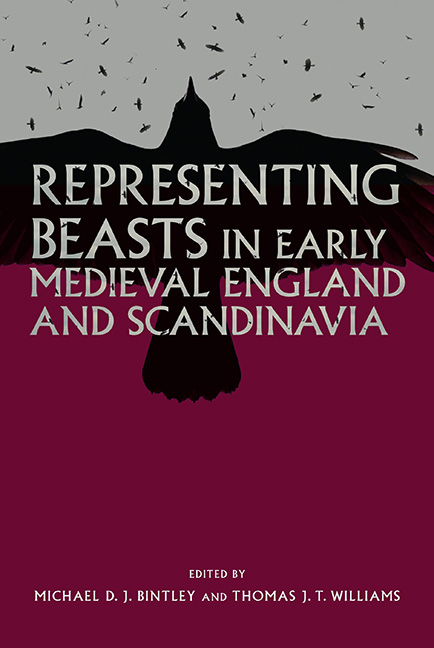Book contents
- Frontmatter
- Contents
- List of Figures and Tables
- Acknowledgements
- List of Contributors
- List of Abbreviations
- Introduction
- 1 Between Myth and Reality: Hunter and Prey in Early Anglo-Saxon Art
- 2 ‘(Swinger of) the Serpent of Wounds’: Swords and Snakes in the Viking Mind
- 3 Wreoþenhilt ond wyrmfah: Confronting Serpents in Beowulf and Beyond
- 4 The Ravens on the Lejre Throne: Avian Identifiers, Odin at Home, Farm Ravens
- 5 Beowulf’s Blithe-Hearted Raven
- 6 Do Anglo-Saxons Dream of Exotic Sheep?
- 7 You Sexy Beast: The Pig in a Villa in Vandalic North Africa, and Boar-Cults in Old Germanic Heathendom
- 8 ‘For the Sake of Bravado in the Wilderness’: Confronting the Bestial in Anglo-Saxon Warfare
- 9 Where the Wild Things Are in Old English Poetry
- 10 Entomological Etymologies: Creepy-Crawlies in English Place-Names
- 11 Beasts, Birds and Other Creatures in Pre-Conquest Charters and Place-Names in England
- Index
- Anglo-Saxon Studies
10 - Entomological Etymologies: Creepy-Crawlies in English Place-Names
Published online by Cambridge University Press: 11 June 2021
- Frontmatter
- Contents
- List of Figures and Tables
- Acknowledgements
- List of Contributors
- List of Abbreviations
- Introduction
- 1 Between Myth and Reality: Hunter and Prey in Early Anglo-Saxon Art
- 2 ‘(Swinger of) the Serpent of Wounds’: Swords and Snakes in the Viking Mind
- 3 Wreoþenhilt ond wyrmfah: Confronting Serpents in Beowulf and Beyond
- 4 The Ravens on the Lejre Throne: Avian Identifiers, Odin at Home, Farm Ravens
- 5 Beowulf’s Blithe-Hearted Raven
- 6 Do Anglo-Saxons Dream of Exotic Sheep?
- 7 You Sexy Beast: The Pig in a Villa in Vandalic North Africa, and Boar-Cults in Old Germanic Heathendom
- 8 ‘For the Sake of Bravado in the Wilderness’: Confronting the Bestial in Anglo-Saxon Warfare
- 9 Where the Wild Things Are in Old English Poetry
- 10 Entomological Etymologies: Creepy-Crawlies in English Place-Names
- 11 Beasts, Birds and Other Creatures in Pre-Conquest Charters and Place-Names in England
- Index
- Anglo-Saxon Studies
Summary
Domestic livestock was a central part of the Anglo-Saxon agricultural economy, both pastoral and arable; wild birds and mammals, too, could be a source of food, provide heroic imagery, and possess mystical associations; exotic and mythical creatures stirred the medieval imagination; and beasts of burden were a mainstay of overland transport. This should be clear from the other chapters in the present volume. It is easy, in such a context, to overlook the less visibly or physically striking parts of the animal kingdom, inhabited by those creatures that are small in stature but vast in number: the tiny beasts and bugs that buzz, creep, crawl and wriggle. Invertebrates often seem too small to concern us; too mundane to arouse interest; too unpleasant even to contemplate. Yet ‘creepy-crawlies’ are fundamentally important to the natural cycles of life and landscape. Some provide us with important resources, while others help to break down the waste products of farming and domestic activity. Others, though, can menace crops and threaten the wellbeing of livestock. These small creatures are an ever-present aspect of human existence, and although they may not often inspire poetic outpourings or the interest of bureaucrats, they must have occupied a certain space in the early medieval consciousness, as they still do today. Their imprint on all forms of evidence may be slight, but is detectable, and their influence on life is just as important as that of the other beasts discussed in this book.
The study of insect remains has certainly proved profitable in archaeological discussion of animal-husbandry, while written texts and artefacts can tell us something about the medieval understanding of insects. This chapter explores the remains invertebrates have left in the toponymic record, and examines the potential of place-names to contribute, in various ways, to our knowledge of the Anglo-Saxons’ relationship with these creatures. Invertebrates are referred to in a reasonably large number of English place-names, though Smith's observation that ‘[i]nsect names (some of which may have been used as nicknames) are frequent in p[lace-]n[ame]s’ requires some qualification: many of them are minor rather than major names, and some examples are now lost. Despite the relative frequency of insect place-names, however, Field's discussion of ‘[c]reatures great and small’ in English field-names went no smaller than rabbits, suggesting that invertebrates are seldom the centre of attention even at the microtoponymic level.
- Type
- Chapter
- Information
- Representing Beasts in Early Medieval England and Scandinavia , pp. 229 - 252Publisher: Boydell & BrewerPrint publication year: 2015



